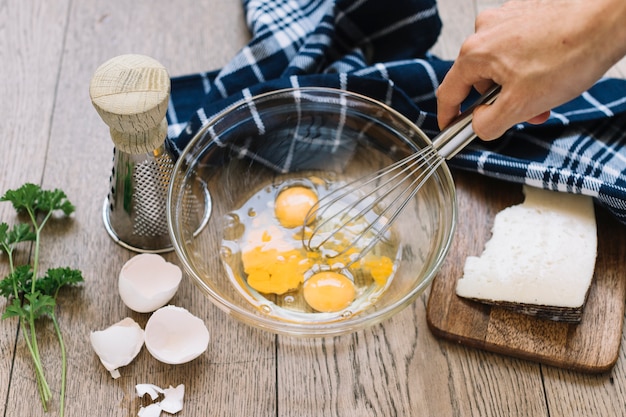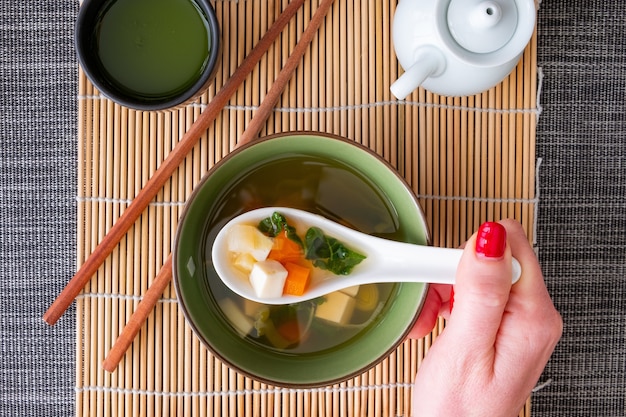Ramen. It’s more than just a meal, it's a symphony of flavors and textures that takes you on a journey to a land of steaming broth, perfectly cooked noodles, and the star of the show: the egg. That's right, a humble egg can elevate a bowl of ramen from good to absolutely phenomenal. But achieving that perfect soft-boiled egg, with its creamy yolk and just-set white, isn't as simple as it sounds. It's a delicate dance of timing, temperature, and technique. I've spent countless hours, many a ramen-fueled night, perfecting the art of the ramen egg. And I'm here to share my hard-earned wisdom, my trials, my triumphs, and the secrets I've learned along the way. Let’s embark on this culinary adventure together!
Part 1: The Eggsploration Begins: Understanding the Basics

You can’t just throw any old egg into your ramen and expect magic to happen. It's all about understanding the fundamentals, the bedrock upon which you'll build your ramen egg mastery.
Eggs, Eggs, Everywhere: Choosing the Right Ingredients
First things first, let's talk about eggs. For me, good ingredients are non-negotiable. Fresh, free-range eggs are the ultimate choice, with their rich, vibrant yolks and sturdier whites. But don't be afraid to venture beyond the ordinary. Try eggs from different breeds like Araucana, with their beautiful blue shells, or even the rare Easter Egger with its multicoloured shell. These unique breeds often have even more flavorful yolks. The world of eggs is your oyster, or should I say, your ramen bowl!
Temperature: The Key to Culinary Success
Temperature is your best friend and your worst enemy in this culinary quest. Too cold, and your egg won’t cook properly. Too hot, and you'll end up with a rubbery mess. The golden zone for a perfect ramen egg lies between 165°F and 175°F (74°C and 79°C). This is where the magic happens, where the yolk transforms into a creamy delight and the white sets just right.
Timing: The Art of Precision
Timing is as crucial as temperature. Cook for too short a time, and your egg will be runny. Cook too long, and it'll be hard-boiled. The trick is finding that sweet spot where the yolk is perfectly creamy and the white is just set. Don’t worry, we'll get to the exact times later. For now, just remember that timing is everything when it comes to achieving ramen egg perfection.
Part 2: Exploring the Methods: Finding Your Ramen Egg Style

Now that we've laid the groundwork, let's talk methods. There are a few different ways to cook the perfect ramen egg, each with its own quirks and advantages.
1. The Classic: The Boiling Method
This is the tried and true method, the one most of us learned from our mothers or grandmothers. You simply bring a pot of water to a boil, gently lower your eggs in, and set a timer. The advantage of this method is its simplicity. It's the most accessible method for anyone, requiring minimal equipment. However, it can be a little unpredictable. The heat can fluctuate, making it harder to achieve perfectly consistent results.
Boiling Method Tips: Mastering the Classic
- Use a large pot to ensure the eggs have ample room to move freely and cook evenly. Crowded pots can lead to uneven cooking.
- Add a teaspoon of salt to the boiling water. This helps season the egg and prevents the white from becoming rubbery.
- Don’t overcrowd the pot. Cooking too many eggs at once can affect the temperature and result in unevenly cooked eggs.
2. The Precisionist: The sous vide method
For those who crave precision and consistency, sous vide is the way to go. You simply place your eggs in a water bath set to your desired temperature. The result is a perfectly cooked egg, every single time. This method is a bit more involved and requires a sous vide machine, which may not be readily available for everyone. But if you're serious about achieving ramen egg perfection, this is the way to go.
Sous Vide Method Tips: The Art of Controlled Cooking
- Use a high-quality sous vide machine with accurate temperature control. Invest in a reliable machine for optimal results.
- Make sure the water bath is completely submerged and gently circulate the water to ensure even heating. This helps prevent hot and cold spots.
- Use a timer to ensure accurate cooking times. Consistency is key when using this method.
3. The Low-Maintenance Approach: The oven method
For those who prefer a more laid-back approach, the oven method is a great option. Preheat your oven to 325°F (160°C). Place your eggs in a baking dish filled with hot water. This method is surprisingly consistent and allows for a bit more flexibility in cooking times. It's ideal for busy evenings when you need a hands-off approach.
Oven Method Tips: Baking Your Way to Ramen Egg Perfection
- Use a baking dish with high sides to prevent water from spilling out during baking. This helps maintain a consistent water level.
- Use a timer to track cooking times and ensure your eggs don’t overcook. Don’t let your eggs become hard-boiled!
- Make sure the water is boiling before you add your eggs to the baking dish. This helps achieve the correct temperature for cooking.
Part 3: The Transformation: Elevating Your Ramen Egg with Marination

Now, the fun part: marination! This is where your ramen egg truly comes alive, where it transforms into something truly special. It's all about adding those flavorful, umami-rich notes that take your egg to the next level.
The Key Ingredients: A Flavor Symphony
- Soy Sauce: This is a must-have, adding a salty, savory depth to your egg. I use a high-quality, naturally brewed soy sauce for the best flavor. A good soy sauce can make all the difference.
- Mirin: A sweet rice wine, mirin adds a touch of sweetness and balances out the saltiness of the soy sauce. It creates a harmony of flavors.
- Sake: This japanese rice wine adds a light, clean taste to your marinade, and helps to prevent the egg whites from becoming rubbery. It adds a touch of elegance.
- Sugar: Just a pinch of sugar will help balance the flavors and create a more complex taste profile. It's the secret ingredient that ties everything together.
Flavor Variations: A World of Ramen Egg Possibilities
Now, here's where you get to unleash your creativity. Don't be afraid to experiment with different flavor profiles. I love adding a touch of chili flakes for a spicy kick, or a pinch of ginger for a little warmth. You can even add a splash of sesame oil for a nutty flavor, or a touch of garlic for a more pungent taste. The possibilities are endless! The world of ramen egg flavor is yours to explore.
Part 4: The Timing Game: Achieving Ramen Egg Perfection
Now, the moment of truth: how long do you cook your eggs for that perfect ramen egg? This is where the magic of timing comes into play. Remember, the goal is a creamy yolk with a just-set white.
Ramen egg cooking times: A Guide to egg textures
| Egg Texture | Boiling Method (minutes) | Sous Vide Method (minutes) | Oven Method (minutes) |
|---|---|---|---|
| Very Soft Yolk (Runny) | 6-7 | 30-35 | 15-18 |
| Soft Yolk (Creamy) | 7-8 | 35-40 | 18-20 |
| Medium Yolk (Slightly Set) | 8-9 | 40-45 | 20-22 |
| Hard Yolk (Firm) | 9-10 | 45-50 | 22-25 |
These are just guidelines. Experiment and adjust the timings based on your preference. It’s about finding your perfect ramen egg texture.
Part 5: The Cooling Process: Ensuring a Beautiful Marbled Appearance
You've got your perfectly cooked egg, but we're not done yet. Cooling is crucial for that beautiful marbled appearance and for ensuring a smooth, creamy yolk.
The ice bath Method: The Classic Technique
This is the tried-and-true method. Simply transfer your cooked eggs to a bowl filled with ice water. This will stop the cooking process and prevent the yolk from overcooking. Leave the eggs in the ice bath for at least 10 minutes, or until they are completely chilled. This ensures that the cooking process is halted and the egg cools down evenly.
The Cold Water Method: A Quick and Easy Option
If you're short on time, you can simply use cold tap water. It won't be as effective as an ice bath, but it's a quick and easy way to cool your eggs down. However, be aware that it may not be as effective at stopping the cooking process completely.
Part 6: The Peeling Challenge: A Gentle Approach to Egg Perfection
Okay, you've got your perfectly cooked, chilled egg. Now it's time to peel. The trick is to peel the egg gently without damaging the white. A bruised white can detract from the beauty of the egg.
Peeling Tips: Mastering the Art of Peeling
- Gently tap the egg all over to crack the shell. This helps to loosen the shell.
- Roll the egg between your hands to loosen the shell further. This will help the shell to come off more easily.
- Start peeling from the wider end of the egg where the air pocket is located. This is the easiest part to peel.
- Peel slowly and carefully, using your fingers to gently lift the shell off. Don’t rush the process.
- If the shell is stubborn, try soaking the egg in cold water for a few minutes. This can help to loosen the shell further.
Part 7: Marination Round Two: A Flavor Infusion
Now we're ready for the final step: marination. This is where your ramen egg gets its beautiful, marbled appearance and its rich, complex flavor. It's the final touch that transforms a simple egg into a culinary masterpiece.
Marination Tips: Creating a Flavorful Egg
- Combine your chosen marinade ingredients in a bowl. I usually use a ratio of 1 part soy sauce, 1 part mirin, 1/2 part sake, and a pinch of sugar. Feel free to adjust these ratios to your liking.
- Submerge your peeled eggs in the marinade and cover the bowl with plastic wrap. Make sure the eggs are completely submerged for optimal flavor infusion.
- Refrigerate for at least 4 hours, or overnight for optimal flavor. The longer the eggs marinate, the more flavorful they will become.
Flavor Variations: Elevating the Flavor Profile
As I mentioned earlier, don't be afraid to experiment with different flavor profiles. You can try adding:
- Chili flakes for a spicy kick
- Ginger for a warm, earthy flavor
- Sesame oil for a nutty aroma
- Garlic for a pungent taste
Feel free to get creative and explore your own flavor combinations.
Part 8: The Grand Finale: Presenting Your Culinary Creation
Now that you've got your perfect ramen egg, it's time to show it off!
Presentation Tips: Adding a Touch of Elegance
- Cut the egg in half to reveal the beautiful, creamy yolk. This is the most visually appealing way to present your ramen egg.
- Place the egg on top of your ramen, gently nestling it into the noodles and broth. This will create a visually appealing and flavorful centerpiece.
- You can also add other toppings to your ramen, like sliced pork belly, seaweed, and green onions. These additions will complement the egg beautifully and create a symphony of flavors and textures.
Part 9: The Moment of Truth: The Taste Test
Finally, the moment of truth: the taste test. Take a bite of your ramen, letting the flavors explode in your mouth. That perfect combination of salty, savory, and sweet, with a hint of creaminess from the egg. Ah, pure ramen bliss!
FAQs: Answering Your Ramen Egg Questions
Still have questions? Here are some frequently asked questions:
Can I use older eggs?
While fresh eggs are ideal, you can still use older eggs. Just know that the whites may be a little rubbery, and the yolks may be a bit more watery. But with the right cooking and marination technique, you can still get a delicious ramen egg. The key is to adjust your cooking times to compensate for the age of the eggs.
What if my egg yolks are too hard?
If your egg yolks are too hard, it means you've overcooked them. Don't worry, it's a common mistake! Next time, try reducing the cooking time by a minute or two. You may also need to adjust your cooling method to ensure the cooking process is stopped promptly.
How long can I keep my marinated eggs in the fridge?
You can keep your marinated eggs in the fridge for up to 3 days. Just make sure they are completely submerged in the marinade. This will help to keep them fresh and prevent them from drying out.
Can I use different types of soy sauce?
Absolutely! You can use light soy sauce, dark soy sauce, or even tamari. Just adjust the amount based on the saltiness of the soy sauce. Each type of soy sauce will add a different flavor profile to your marinade, so experiment and find your favorite.
What kind of ramen is best for ramen eggs?
Any type of ramen will work, but I personally prefer a rich, flavorful broth like tonkotsu or shio. The creamy yolk of the ramen egg pairs perfectly with the savory, umami flavors of these broths. However, ultimately, it’s about what you enjoy!
Now you're equipped with the knowledge and techniques to create the perfect ramen egg. Go forth and conquer your ramen bowl!
Everyone is watching

Prime Rib Roast Cooking Time Chart: Per Pound Guide
Cooking TipsPrime rib roast. Just the name conjures images of lavish dinners, crackling fires, and hearty laughter. It’s ...

How Long to Bake Potatoes in the Oven (Perfect Every Time)
Cooking TipsBaked potatoes are a staple in my kitchen. They're incredibly versatile, delicious, and surprisingly easy to m...

Perfect Rice Every Time: The Ultimate Guide to Cooking Rice
Cooking TipsAs a self-proclaimed foodie, I've always been a bit obsessed with rice. It's the foundation of countless cuisi...

The Ultimate Guide to Cooking Asparagus: Tips, Techniques, and Recipes
Cooking TipsAsparagus. The mere mention of this spring delicacy conjures up images of vibrant green spears, crisp and burs...

Ultimate Guide to Cooking the Perfect Thanksgiving Turkey
Cooking TipsThanksgiving. Just the word conjures up images of overflowing tables laden with delicious food, the scent of r...
